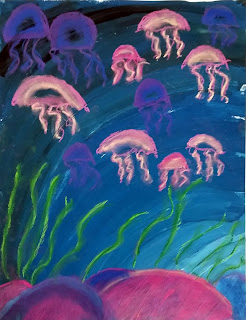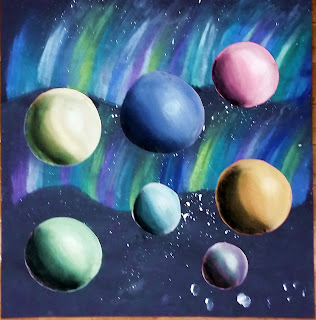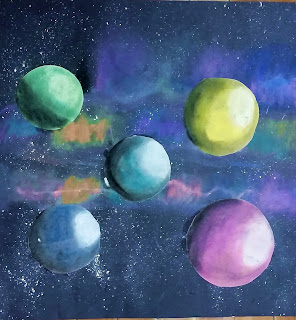Most of us know Wayne Thiebaud for his delicious dessert paintings. You'd be hard-pressed to find an art teacher who hasn't, at some point, done some adorable lesson on creating colorful confectionaries. But enough with the aeonomonpea, and onto a different side of Wayne Thiebaud.
I came across these landscapes in an article I found online while researching his work for what else, but a project on cupcakes. I love the idea of teaching children landscapes because of their versatility.
There are so many elements and principles of art and media that you can tie into the subject matter that landscapes have become a pretty regular thing within my art curriculum. However, wHen I saw these, I thought it was a brilliant twist on the traditional landscape because of the aerial perpective Thiebaud used.
Here is the blopost where I first came across the landscapes:
The project I came up with to go along with Wayne Thiebaud's landscapes was a mixed media using glue, chalk pastels and tempera paint. The whole project took about 5-40 minutes periods. I did this lesson on 18 x 20" and 16 x 20" purple and green construction paper with both my second and third graders. My second graders got the smaller purple paper.
For this project I also "flipped" my classroom. The conventional definition of a flipped classroom would be where a teacher would present the contents of the days lesson via a video source at home to the students as part of their "homework", and then that assignment would be reviewed or re-taught back in class as a way to correct or adjust any misunderstandings or clarify any confusion. The idea behind it being that the students would come in with the baselevel understanding of what they were learning for the day and you could have a more in-depth and successful learning experience in the classroom haven't already reviewed the initial information.
In the context of an elementary art room, The traditional idea of a flipped classroom isn't really possible, so in a context that works for me, a flipped classroom would be where I use video demonstrations instead of actual demonstrations to present the content that my students are going to be doing for the period. This modified flipping is amazingly successful and here's why:
A standard demonstration:
1. All the students in the class are squished around one table and most of the time are jockeying for a "choice" spot close to the teacher or materials. (I mean think about the amount of times you've had to say to the students "don't run, walk around the table").
2. Once all the students are around the demonstration area because of the close proximity to one another you get students who were standing together who shouldn't be together and students were instantly distracted by one another. Oh, and then thats usually followed up with talking.
3. The majority of your students are watching the demonstration sideways or upside down.
4. If you forget something that should've been included in the demonstration after you've let the kids go back to their seats from the demo table, whatver you meant to say but forgot to is pretty much a lost cause.
5. Many times you feel like you have to rush through the demo or can't complete a whole step of it while showing it to the children because you're on a strict time frame when you have them all in a situation where there huddled around the demo table under the above four conditions.
6. And before I forget, it's horribly annoying to be interrupted while speaking and/or losing your train of thought because someone's calling out over you while you're trying to teach them something.
A video demonstration:
1. Everyone gets a great view.
2. You don't waste any time transitioning.
3. Being interrupted during the video demo is more frustrating for the students then it is for you. However, when the children are watching a video the amount of interruptions seems to go down exponentially.
4. You don't have to worry about not having the correct materials handy during the demo or forgetting to mention something because a cell phone is incredibly easy to edit videos with.
5.You can patiently and methodically demonstrate all the steps you want the children to see because of the handy time lapse video feature, or simple careful planning and editing of your video before you show it.
Using mostly video demonstrations, here's how the lesson broke down:
On the first day I talked about and showed some images of Thiebaud's landscapes and then had the students fish through a whole bunch of color printouts with both photographs of Ariel landscapes and examples of the artsits aerial landscape paintings. The children chose one that they liked and used it as inspiration to draw the shapes for their own landscape. On day two we learned a little bit more about the life and work of Wayne Thiebaud and then I had the children outline over their pencil with Elmers glue to create a raised surface. On day three I demonstrated how to use chalk pastels and how each shape had to have a minimum of two colors in it and the children went to work. They worked with the chalk for another perod or two after that. Somewhere around day five I video demo out how to add texture by creating designs in paint on top of the chalk pastels. This last stop was something I thought of at the very end of the project after the children had already done all the chalk pastels. I felt like the lesson didn't look "finished "enough and as a last ditch effort to spruce up the project I decided to take a chance and use paint on top of the chalk. I can't tell you how glad I am that I took the chance because the paint texture on top of the chalk is really what makes the lesson come to life.
I think you'll agree that the finished results are pretty fabulous!













































